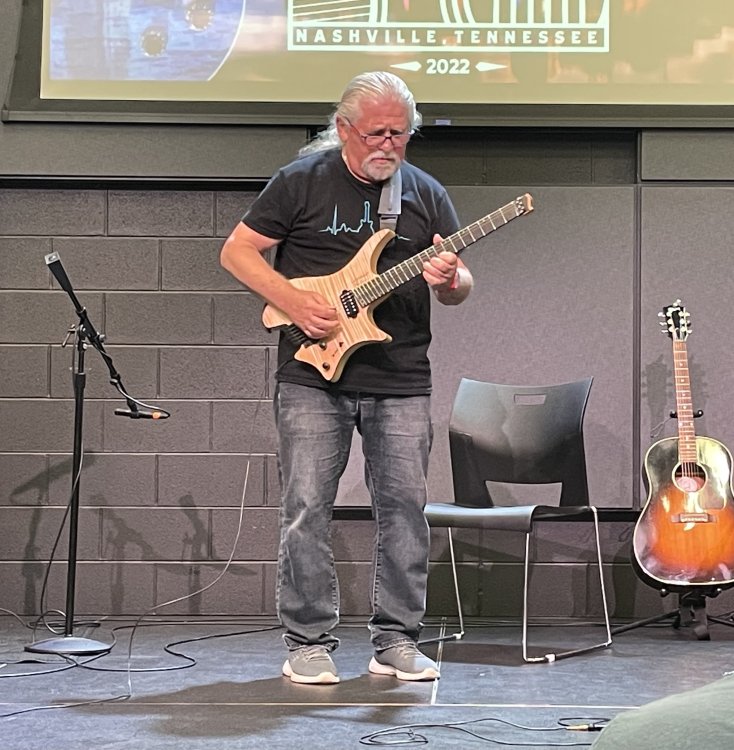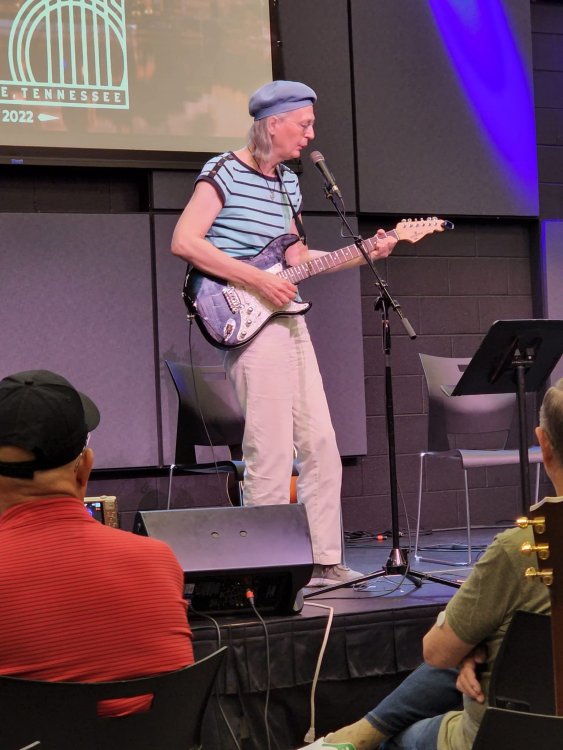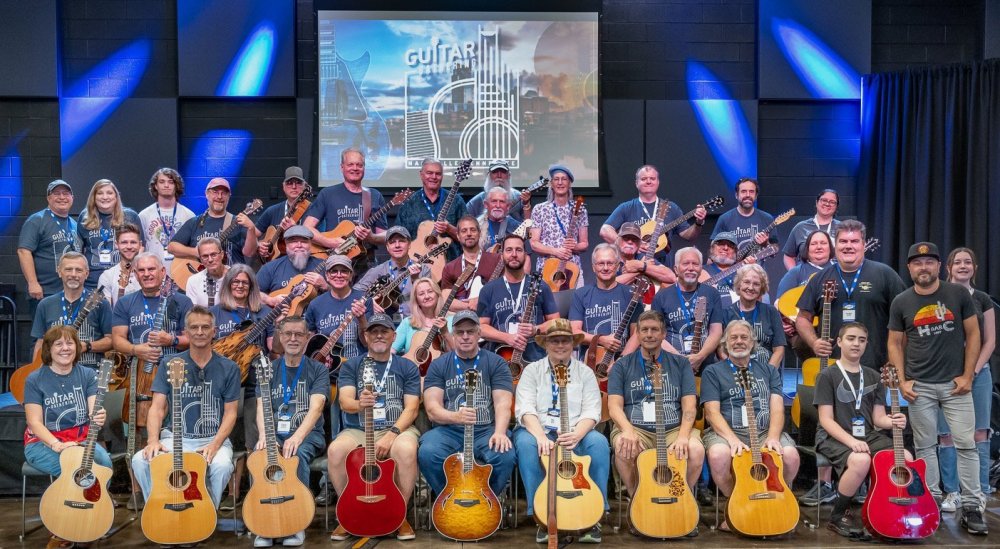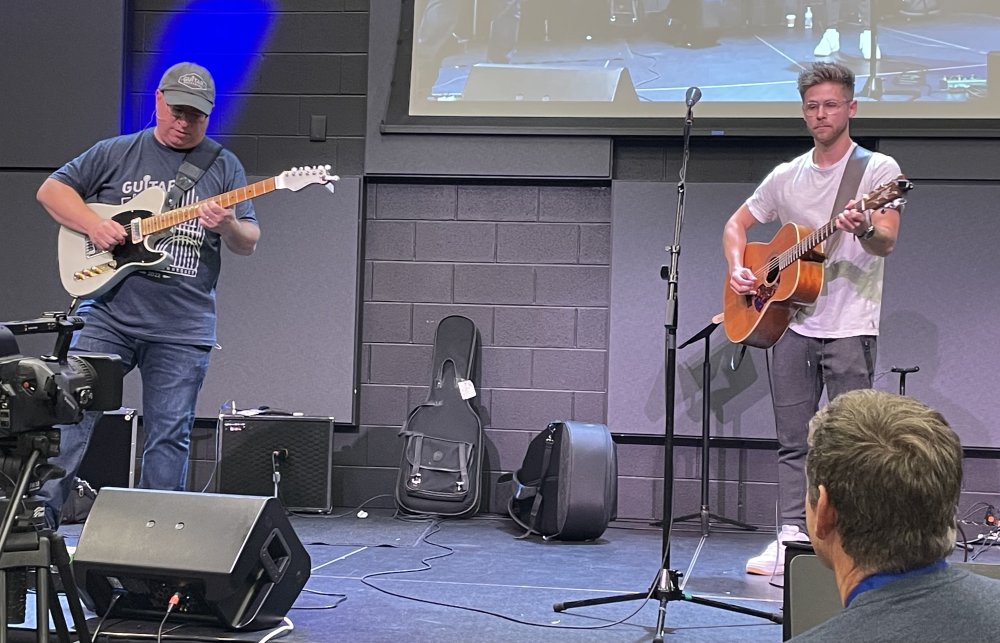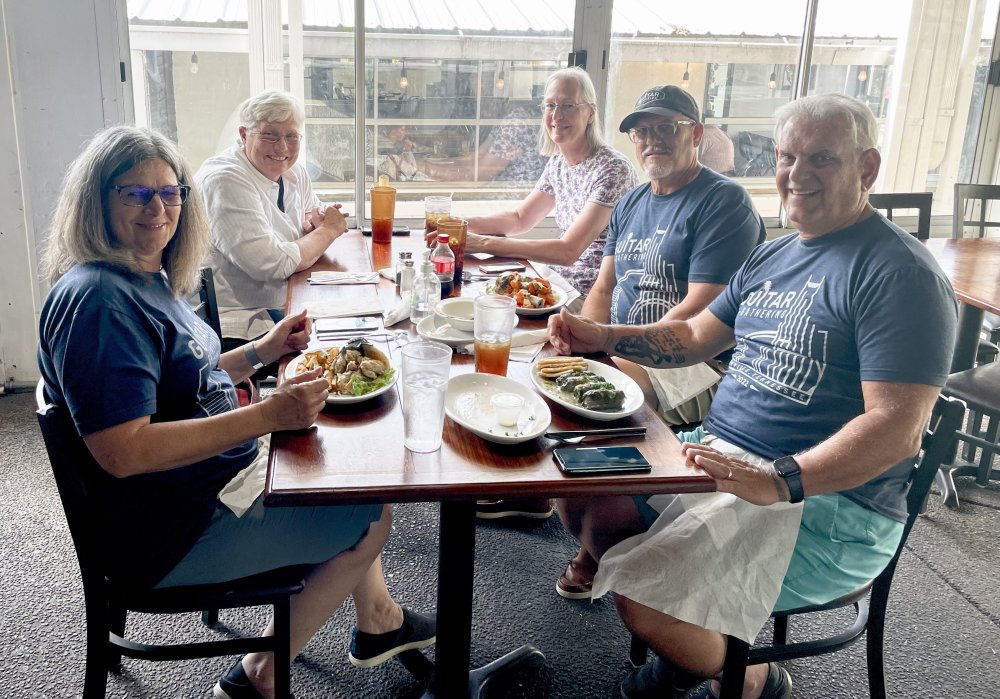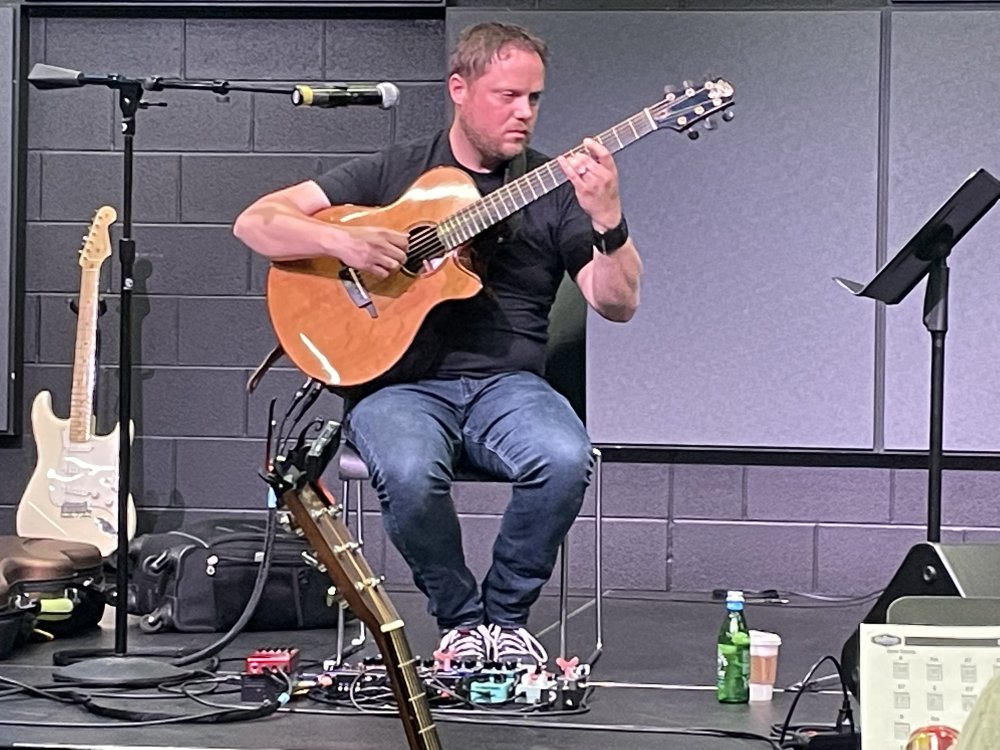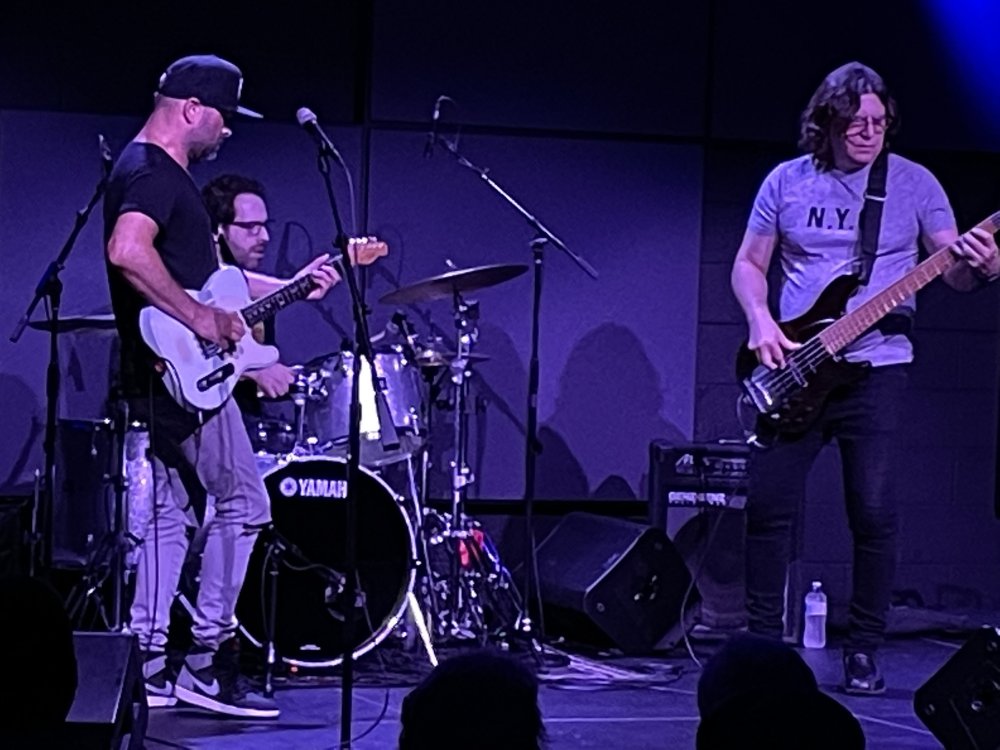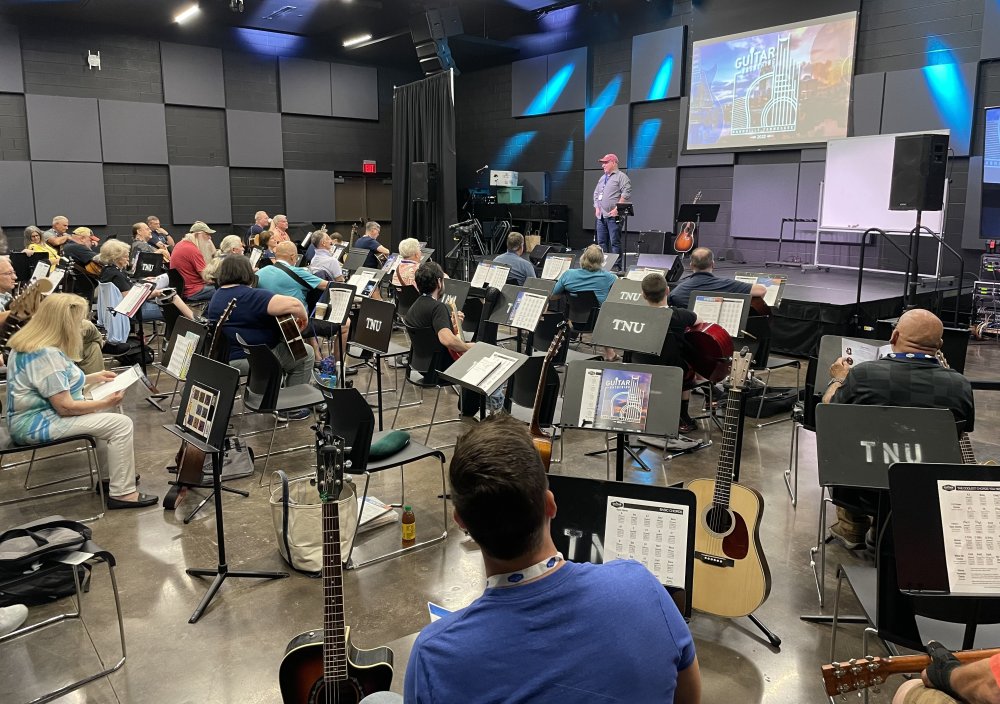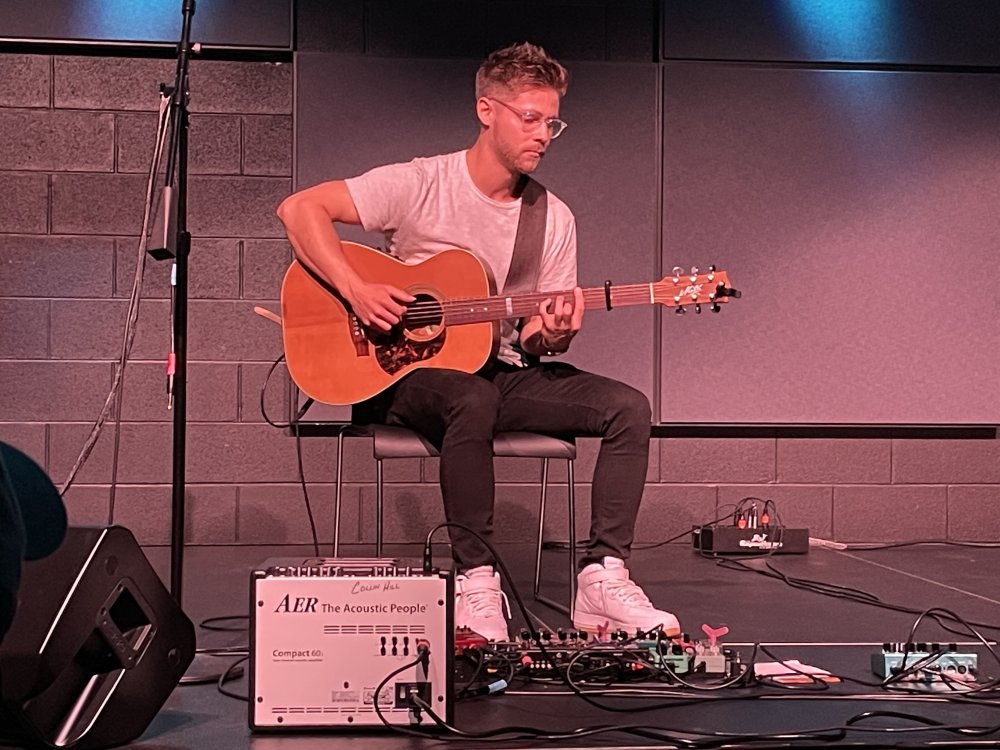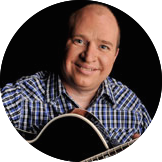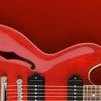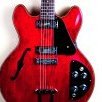-
Posts
819 -
Joined
-
Last visited
-
Days Won
211
Content Type
Profiles
Forums
Gallery
Events
Articles
Blogs
Downloads
Everything posted by DianeB
-
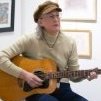
2022 Fall Fingerstyle Retreat
DianeB replied to jasn's topic in Guitar Gathering Conferences & Retreats
-
@Eduardo It's not important that the thumb stay on the three low strings, unless the music calls for it. It's important that the thumb does what you want it to do. Session 10 is a toe dip into the shallowest water of fingerstyle and classical. You can't go wrong with advice from Mauro Guiliani or, say, Christopher Parkening.
-
@Eduardo Glad you asked, because that question also arises frequently. I wondered myself. From the Harvard Dictionary of Music: "Suspension (under 'Counterpoint'): normally a dissonant tone occurring on a strong metrical position, having been sustained (or "suspended" or "prepared') from an initial attack as a consonance and converted to a dissonance as a result of motion in another voice. It is most often resolved downward by step." (Italics mine.) So whether to notate a chord as G2 or Gsus2 is merely a matter of convention and preferred usage. If we regard the dissonant note (the second or fourth in the chord) as "lifted", then the physical meaning of "suspension" is applicable to a fourth but not a second. Steve reports that "sus2" usage is more common in the UK, and "2" in the US. I can't say, because I've seen "sus2" over chord blocks in a lot of music books here in the US. He uses "2". It seems to be like "color" vs. "colour". And yes, this is the essence of almost all Western music from the Classical period on, tension and resolution. -- Diane
-
@Eduardo Good eye, my dear man! Yes, this has been called out here before, but I've forgotten where, so let's clarify. A major triad is the root, major third, and perfect fifth, abbreviated 1-3-5. A suspended fourth (sus4) chord is the root, perfect fourth, and perfect fifth, 1-4-5. As you observe, the middle pitch is raised a semitone to form this from the major triad. At this stage in the course, to avoid unnecessary complication, Steve uses "sus" to mean "sus4". There are also "two" chords, written as either "sus2" or simply "2", as in G2 (= Gsus2). These come later, in Session 12. He also makes another simplification here for the student, again for the same reason. He does not distinguish between "sus4" and "7sus4", a suspended dominant seventh, which is 1-4-5-b7, referring to both as "sus". The open position Em7 chords shown are variations on 1-b3-5-b7 (E-G-B-D). The open position Dsus (Dsus4) is 1-4-5 (D-G-A) and the open Esus (Esus4) is also 1-4-5 (E-A-B). The first position Fm7 is 1-b3-5-b7 (F-Ab-C-Eb). But the "Fsus" illustrated is actually an F7sus4. Fsus4 is 1-4-5 (F-Bb-C), but F7sus4 is 1-4-5-b7 (F-Bb-C-Eb). The A# pitch class is not in the key of F, but rather its enharmonic, Bb. Note the presence of the b7th (Eb). A true Fsus4 (1-4-5 = F-Bb-C) in the first position is 133311, or an Esus4 shape two frets behind a full barre. Even in Steve's full chord chard (attached), he has labeled F7sus4 as "Fsus7" (?!), complexicating things even more. Fsus4 does not appear on the chart probably because Steve has found little use for it. In classical guitar, it's not that unusual. The F7sus4 shape is slightly easier to form, and it works harmonically because the (added) b7 will function as a leading tone much like the 4th. Steve is not being misleading, but doing what all good teachers do in not introducing complexity too early and needlessly. But sharp eyed students will catch these moments every time! Chords You Need to Know.pdf
-

Session 1 - Starting Off Right
DianeB replied to NeilES335's topic in Gibson's Learn & Master Guitar
@Matt_B Hi, Matt, it happens. Life will always be there. Be kind to yourself and keep your expectations modest. Over the years the discussion board has accumulated (and Doug collated) a mountain of good advice that you can refer to as you need. But here in the beginning, I suggest you identify a small window of time in each day, 10 to 30 minutes, that will be free of distractions, in which you can focus on music. An appointment with yourself, every day, same time. No excuses. Steve explains here. If possible, it should have something of each of these four elements: (1) warm up, (2) skills, (3) songs, and (4) exploration. At first, it will mostly 1 and 2 and a bit of 4. Your finger tips might get sore, especially on a steel string acoustic. Don't practice with pain; your finger tips will gradually toughen and your endurance will grow. Have your guitar professionally set up, even if it is new, to ensure its maximum playability and proper intonation. The best advice on music practice I've found has been distilled into a delightful little volume by guitar instructor Tom Heany, "First, Learn to Practice". This and related books appear in my Reading List. Lesson 1: Enjoy your practice! -

Session 1 - Starting Off Right
DianeB replied to NeilES335's topic in Gibson's Learn & Master Guitar
@Matt_B Relax. I can not find any errors in the tablature in my lesson book through Session 10, and it's a first edition (possibly 9th printing). It's possible I missed something, but it's unlikely because I made lots of pencil annotations, such as note names, and I would have corrected an error if I found one. My Bonus Resources book is version 1.2, and it's possible some typos were in the earlier printings of that. The only hiccup I corrected was p. 35, exercise 6: it should read "Key Signature = G" (not F#), and that's trivial. On p. 98 of the Bonus Resources book, Steve refers to typos in the tab of Canon in D in the Lesson Book, but both of mine match exactly, so those typos must have been in an earlier printing. -

Session 1 - Starting Off Right
DianeB replied to NeilES335's topic in Gibson's Learn & Master Guitar
@Matt_B Welcome to the course and the discussion board! Yes, when you first open that lesson book and consider all that's ahead, it can seem overwhelming. But you will be making enjoyable music quite soon. Make full use of all the advice here (see Doug's link above), at least the parts that speak to you. Here is some of the best I've read. Whatever difficulty you might encounter, it won't be new — someone here will have met the dragon before and can help you conquer it. I collected a few other resources here that might be useful as you progress. Happy practice! -
untilLive Lesson with Steve Krenz from Nashville, TN, 7:00 pm CT. Jazz Soloing with the Jazz Deck.
-

Finally!!!! I have finished Learn and Master Guitar!
DianeB replied to matonanjin's topic in Guitar Playing & Technique
Wow, Ron, congratulations! That is quite the accomplishment. Take a bow! 👏 -
@Dbarker Hi, there, and welcome to our forum! Because you're new, some background could be helpful. You might already be aware that a number of years ago, Steve created a complete guitar course on DVDs and CDs, published by Legacy Learning Systems in association with Gibson. More recently, he has repurposed and enhanced much of that material in his Live Lessons and workouts. The "How Music Works" series is essentially the music theory portion of the course. The first lesson is concerned only with concepts: simple intervals (seconds), major and relative minor scale relationships, and key signatures. The practice of locating and playing major scales is addressed later, and quite thoroughly in his major scale mastery workouts. Of course, you can work on these sequentially or simultaneously, as you like. There are many systems and aids for learning the notes on the fretboard; find and use what works for you.
- 1 reply
-
- 1
-

-
Hi, there! And welcome to our group. May I offer two suggestions, one internal and one external. First, the internal: after a couple of years, you are enjoying guitar and want to progress. Now you recognize the overwhelming number of options open to you. We all go through this. It's time to consider what part of your life you want guitar to occupy. How much time can you realistically devote to it each day? What style of music are you attracted to? And what do you want to do with your music? Play for yourself and friends? Join an ensemble or band? What are you willing, and not willing, to sacrifice for it? As you contemplate these questions — and make no mistake, this is work — the answers to your questions of what is best for you will soon become obvious. Which brings me to my second suggestion, the external, and it will help you with the first. Find, and bring into your personal circle, as many experienced musicians as you can. Music teachers, church musicians, open mic-types, professionals, anyone who is farther along the path. You want to be seek out those who will encourage you, coach you, and be stone cold honest with you. It might be just for one conversation, it might develop into a long friendship. It is quite impossible to research every option. That’s no excuse for doing some research. The magic word is practice. That comes first. Here are a few words from Steve you might find helpful. I hope you make many new guitar friends here and at home!
-
Obviously I can not speak for Steve, but I can share some insights gleaned from my from ten years here. The Learn and Master course was a “work for hire” by Steve. He does not own the rights to the content; they belong to Legacy Learning Systems. It would be up to them to migrate the content to another platform, and nothing suggests to me they have plans to do so. This idea has come up many times before. I think Steve recognizes that now there are many online avenues for learning guitar, and rather than compete directly, he occupies a different niche. He teaches in academic settings (and is doing so as I write this), conducts his YouTube Live Lessons, hosts two annual guitar conferences, and performs professionally in multiple capacities. He has produced specialty courses for fingerstyle and blues that are available in the store. Anyone who wants to learn to play guitar will find a way. The cost of the L&M physical media, along with a DVD player, is trivial when compared to a few hours of private lessons from a comparable professional.
-
No Live Lessons for the last two weeks in July, as Steve will once again be conducting a Teaching Guitar Workshop at Trevecca Nazarene University. For those who are curious about this national outreach program in music education, I’ve looked up their web site. As it says: “The Teaching Guitar Workshops were started by members of GAMA, NAMM and NAfME in 1995. The objective: help school music educators start or enhance classroom guitar programs and deliver more music making opportunities to children. Between 1995 and today over 4,000 school music teachers across the United States and Canada have enjoyed TGW. GAMA’s studies suggest that over 2 million students have learned guitar in schools because of the TGW.”
- 1 reply
-
- 1
-

-
untilLive Lesson with Steve Krenz from Nashville, TN, 7:00 pm CT. Chord Inversions, Part 3.
-
@ChristopherArt It's not a typo, Christopher. In that G7 shape the D (the fifth of the chord) is doubled on beat 2; this is evident in the staff notation. You will often see the D doubled in G major in the open position as 320033. The Guiliani studies provide training for movements and shapes that are rarely encounter in simple strumming.
-
untilLive Lesson with Steve Krenz from Nashville, TN, 7:00 pm CT. Chord Inversions, continued.
-
untilThe 2022 Fall Fingerstyle Retreat will be held at the Deer Run Retreat near Thompson's Station, Tennessee. Richard Smith, Sean McGowan, Gareth Pearson. Full details here.
-
If you missed out on this year's Guitar Gathering, there's still time to check out these upcoming offerings: Ashokan Acoustic Guitar Camp 2022, July 25 - 29, Olivebridge, New York. Pete Huttlinger Guitar & Fly Fishing Camp 2022, August 7 - 11, Livingston, Montana. Acoustic Alaska Guitar Camp 2022, August 28 - September 3, Wasilla, Alaska. Frank Vignola’s Mile High Jazz Guitar Camp 2022, September 6 - 9, Arvada, Colorado.
-

News from the 2022 Gathering
DianeB replied to DianeB's topic in Guitar Gathering Conferences & Retreats
Doug and Ron, see my private messages. -

News from the 2022 Gathering
DianeB replied to DianeB's topic in Guitar Gathering Conferences & Retreats
Epilog I’m about to load the Camry for the long haul home. Thanks for reading. Our gathering was smaller this time than recent years. This dialed down the craziness but added to the intimacy. We had more time with each other in the halls and the lessons and the jams. Trevecca has finished renovating the student center and dining hall, so perhaps that will be open to us next year. A new seven story residence hall is rising across from the Jackson Music Center. Murfreesboro Pike remains perpetually under repair. The new gray paint scheme on the walls of Gruhn Guitars sets off the instruments nicely, George’s reptiles are still happily warming themselves, and Greg Voros is doing much better. Roll credits: Steve’s son Timothy, who assisted with the gathering since 2014, has moved on into the Real World. But Daniel and Grace and the baby have returned to make their home in Nashville, so we can expect babysitting reports occasionally on Tuesday nights. Steve’s neighbor Mackenzie assumed Timothy’s former positions at the video camera and the store. She’s a junior in high school, still contemplating what’s ahead. I used to counsel students for a living; I know that facial expression well. The sound board and new second video display were in the capable hands of Trevecca alum and employee Aaron, who made everyone sound amazing. Once again Chuck Thompson herded us together for a great group photo. Dommie and Sharon (Episode 4 photo) found a charming Greek restaurant. Dave once more had a load of donations for Instruments of Joy. IOJ’s Joshua Macleod stopped by to describe their ministry to us. It is a sweet feeling to know that a guitar I once learned on is now in the hands of an appreciative girl in Mexico. We were welcomed to Trevecca by a professor whose name I unfortunately did not catch when Steve introduced him, but he said that they were happy to have us on campus once again. I had to pass up a few sessions, so I hope others can report on the jazz, songwriting, and worship music workshops. In quieter moments, I learned that the past year has been very hard for some of our guitar family. Discretion prevents me from elaborating, but I can say that Pat and I found that our lunchtime benefactor was a fellow student who nearly lost his life to Covid earlier in the year and wanted to give something back. Someone said to me, referring to how close our clan is, “This is my Christmas.” That’s just how I feel. If you couldn’t make it this year, and a lot of our gang couldn’t, please know we were thinking of you and asking about you. You know who you are. Until next time, whenever and wherever that is, I leave you with lessons from Steve: go slow, go deep, and put your music out there in the world. Somebody really, really, needs it. -

News from the 2022 Gathering
DianeB replied to DianeB's topic in Guitar Gathering Conferences & Retreats
Memo to: Shareholders From: Producers Another fantastic shooting season has wrapped! Congratulations to our awesome writers and directors, shoe-ins for Emmys! Looking forward to boffo ratings and props from Variety! Season 7, Episode 5 (Finale): “Dance with Me“ Synopsis: Mystery song trifecta pays off for Paulette and Steve on “Isn’t She Lovely”. In the Student Showcase, Elijah hits the power chords, Dommie, Reg, Barbara, Don, Charlie and others lay down the ballads, rock medleys, originals and sweet leads. Diane summons a flash mob to get up and dance to ELO’s “All Over the World”, successfully distracting the audience from her guitar output. Steve announces the Fall Fingerstyle Retreat is on for October 27-30, and extends his parting reminder that “Your music matters.” As Daniel and Grace arrive with their son — Steve and Paulette’s grandson — in a stroller, the ensemble says their goodbyes. Cases click and zip, and guitarists hug and wave as they load their cars. Aaron pushes the Master Audio switch to OFF. -

News from the 2022 Gathering
DianeB replied to DianeB's topic in Guitar Gathering Conferences & Retreats
Memo to: Cast From: Continuity We’re down to a gaffer, makeup, one sound guy, and me. Directors and the rest of script left for NOLA. If no one objects, Diane said she’d write us out so we can get back to our families by next season. Hope you’re up for improv. Season 7, Episode 4: “Trapped in Time” Synopsis: Paulette stumps the band with another mystery song workout: Steve teases the chords and a chromatic run until “Uptown Funk” is revealed to the delight of all. Paulette nods at Steve, “Told you so.” Guthrie Trapp begins his masterclass on plain water and good natured self deprecation. Steve arrives with black coffee. Caffeine and theobromine migrate into Trapp neural system, synapses fire, and lesson runs a half hour over, also to the delight of all. Except Steve, who now must push afternoon sessions back. Pat and Diane get waved off the register at the Subway a third time and throw up their hands. Paulette collects the courageous students for music theory class. The remaining 95% pile into Steve’s chord progression workshop. Blues coach Corey Congilio shows how to spread 12 bars across 12 frets. Collin and Steve explain how thoughtful choice of preamps, DI’s, pedals, and soft cases can enhance fantasies of avoiding thoughtful choice of which notes to play. Steve asks Diane to put down the Nerf ball and take a bow. -

News from the 2022 Gathering
DianeB replied to DianeB's topic in Guitar Gathering Conferences & Retreats
Memo to: Director From: AD Who hired all these extras? I counted 40 something today. We can’t pay a per diem, and all we’ve got for a caterer is a Subway down in Death Valley. SAG is going to slam us. And I still need those call sheets for tomorrow. Season 7, Episode 3: “These Go to 11“ Synopsis: Ensemble returns at daybreak for strumming workout just before road asphalt melts. Steve invites Elijah on stage for private tutoring. Trevor Gordon Hall offers masterclass in fingerstyle; in Q & A, attempts to quash rumors he comes from the planet Digitalis and has 12 fingers. Back at the Subway, Diane and Pat discover, again, that their money’s no good. They look around suspiciously for their benefactor, drawing side-eye from a Metro police officer. Post nap workshops continue with Collin, Steve, Paulette, and Kim. Jonathan Allen teaches how to use guitar in worship settings, and Andy Reiss comps for the jazz soloists. Meanwhile, at the store, Mackenzie wonders why all the new GG hooded sweatshirts aren’t moving. In the back of Steve’s music theory class, Diane, at Steve’s suggestion, daydreams of shooting Nerf ball hoops. The jams resume. The ensemble comps in E minor as Charlie and Rick take turns on stage improvising with Steve. As night falls, the asphalt reverts to semisolid while the Guthrie Trapp Trio launches a hypersonic Telecaster. -

News from the 2022 Gathering
DianeB replied to DianeB's topic in Guitar Gathering Conferences & Retreats
Memo to: Producer From: Screenwriter Your script deadlines are bleeping insane. If you want to make a bleep documentary, get your bleeping crew in here and shoot it yourself. I have to bleep sleep. If the suits want something, give them this. Season 7, Episode 2: “Tangled Up in Blues“ Synopsis: Steve welcomes the entire ensemble of 45, including guitarists from Thailand, Israel, and 12 year old Elijah. Steve’s chord practice leads in to a masterclass by finger picker David Grier, whose pandemic beard is now shorter, and wit drier than before. The Subway at the end of the driveway is flooded at lunchtime with musicians in various stages of heat stroke. The ensemble splits up for fingerstyle lessons with Collin, blues with Steve, theory with Paulette, songwriting with Kim McLean, and CPR as required. Jams follow with Pat Lindgren for popular classics, Steve for jazz, and blues with Tony Lane, who, disregarding his own personal safety, picks on Diane for a 12 bar solo. Lessons conclude as Steve explains, by popular demand, matrix algebra for session musicians (billed as the Nashville Number System). In the evening, Collin Hill and Trevor Gordon Hall shoot off acoustic fireworks with their bare hands.

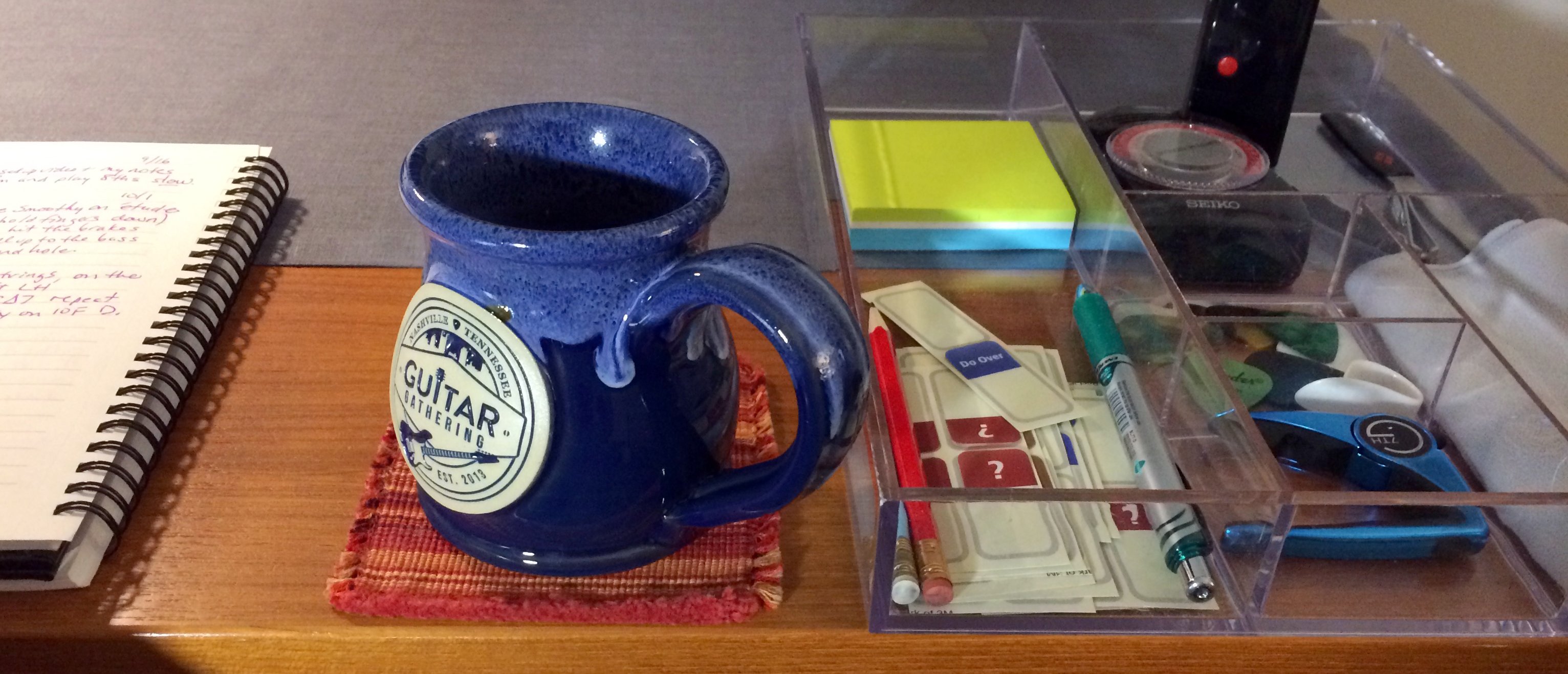
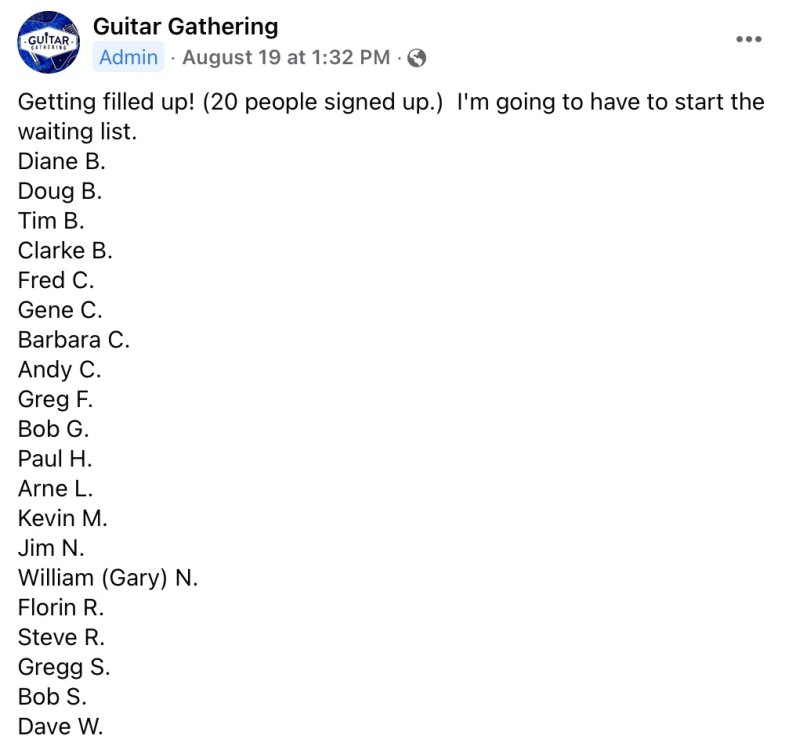
.jpeg.d46cdcd1fb2ff2c945f0372e96dc9918.jpeg)

